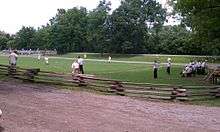Vintage base ball
Vintage base ball is baseball presented as if being played by rules and customs from an earlier period in the sport's history. Games are typically played using rules and uniforms from the 1850s, 1860s and 1880s. Vintage base ball is not only a competitive game, but also a reenactment of baseball life similar to American Civil War reenactment. Players dress in uniforms appropriate to the time period, and many teams appear to be direct copies of teams that existed in the late 19th century. The styles and speech of the 19th century are also used while playing vintage base ball.

The game's name is typically written "base ball" rather than "baseball", as that was the spelling used before the 1880s.
Rules and game play
Although rules differ according to which playing year is being used, there are some mostly common rules differences between the modern game and vintage base ball. In rules of years prior to the 1880s, the pitcher's role was to initiate the action by offering an underhanded throw to the batter, or "striker", in much the same way that a basketball referee offers up a jump ball to begin play.[1] Since this type of pitching often caused the batter to hit lazy, foul pop-ups, catchers played their position approximately twenty to twenty-five feet behind the batter, and wore no protective equipment.[1] There are typically no fences as base ball is mostly played in fields and green spaces. However, obstacles (e.g. trees, building, etc.) often come into play. In many of the rules sets the ball can be played off of one bounce to get a striker out. Catching the ball can be very difficult because no gloves are used. The lack of gloves, underhand pitching and other rules make vintage baseball similar to the sport of British baseball.
References
- Morris, Peter (2010). Catcher: How the Man Behind the Plate Became an American Folk Hero. Government Institutes. p. 41. ISBN 978-1-56663-870-8. Retrieved 11 July 2012.
External links
| Wikimedia Commons has media related to Vintage base ball. |